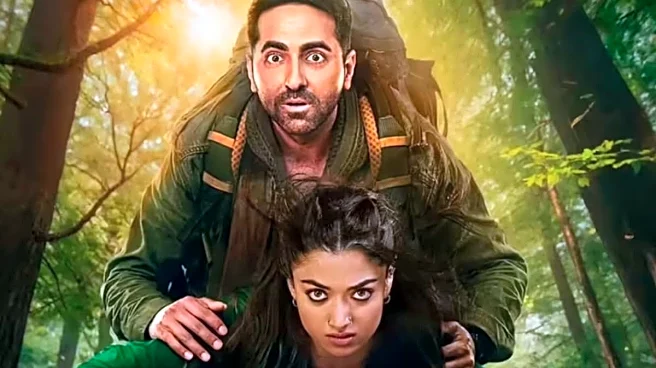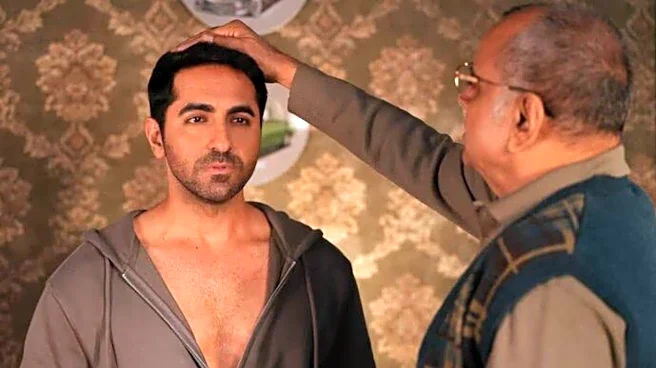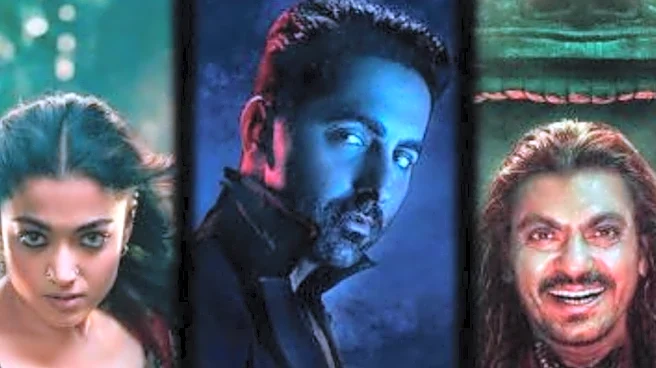"It came together very coincidentally," Sarpotdar laughs. "My only thought was that I wanted to make it very unique and Indian, something that’s relatable. It doesn’t have to be the vampires that we know. It has to be our own version, and that’s where the Betaal concept came in."
The idea of rooting Thamma in Indian mythology rather than European lore shaped the film’s identity. "When you’re looking at an Indian version of a vampire, then if it’s a Betaal, there has to be a certain origin story: why Betaals, how Betaals. I came across some interesting references where the Betaals were linked to Goddess Kali and her army of warriors who fought Raktabīja and drank his blood to become saviours. We found that fascinating and decided to build it into the horror-comedy universe," he says.
For Sarpotdar, that local mythology sets the Maddock universe apart. "Right from Bhediya, Munjya, and Stree, there’s always a sense of folklore attached to these films. Even with Betaals, I wanted that connection."
When he came on board, the project looked very different. "I was given a script called Vampires of Vijay Nagar," he says. "I liked the story, but I didn’t think 'vampires' felt Indian enough. It’s a very European idea — dark, cold, always night. India is different — our climate, our geography, everything. So, I said, let’s not call it that. Let’s bring in the Betaal folklore. If we can add that Indian touch, it might become something special." That’s how
Ayushmann Khurrana was already part of the project when Sarpotdar joined. "Amar (Kaushik) and Ayushmann (Khurrana) had been discussing it even before I came on board,” he recalls. "Ayushmann was always the right choice. He’s lovable, simple, a bit goofy, that typical Delhi boy who suddenly becomes a superhero. In this universe, you have actors like Rajkummar Rao and Varun Dhawan — talented performers who can also play strong characters. Ayushmann fits perfectly in that space."
With Rashmika Mandanna, Sarpotdar says the process was full of trust. "I told her it’s going to be one of her most physically challenging roles because there’s a lot of stunt work. She’s terrified of scary movies. When she came to watch Munjya, she literally had to close her eyes! But she told me, 'That’s my job as an actor, to make it believable.' She came in with a lot of faith and followed everything I asked her to do."
Nawazuddin Siddiqui’s character, Yakshasan, came from an unexpected source. "When I met him, I told him, remember Vikram aur Betaal? The Betaal was cunning, mischievous, cracking jokes, making Vikram believe he’s his friend, but ready to strike when Vikram let his guard down. I told Nawaz bhai, 'You have to be that Betaal.' Someone who looks funny and harmless at first, but you slowly realise he’s manipulating you. He loved the idea."
While Munjya was more of a standalone story, Sarpotdar says Thamma serves as a bridge within the larger universe. "With Munjya, the connection to the universe came only at the end with Varun and Abhishek’s (Banerjee) cameo. But in Thamma, the crossovers are part of the main narrative, not as blink-and-miss cameos but as part of the story. These aren’t guest appearances to add glamour; they’re tracks that interconnect and move the universe forward."
He adds, "Now that we’re five films in, Thamma became that bridge, the film where you start seeing all these worlds collide in the story itself. From here on, you’ll see the universe unfold more fully."
Music, he says, plays a huge role in both storytelling and marketing. "I see music in two ways — the background score and the songs," he explains. "The first track we made was Rahein Na Rahein Hum, which captured the soul of the love story. Everything that came after, the dance numbers, the promotional tracks, was to create excitement around the release. Dinesh Vijan, as a producer, is very involved in that process because in India, songs are vital for visibility. If the music works, the film works."
Balancing horror and humour, Sarpotdar says, is all about knowing your audience. "These films are meant for families. You want to make it scary enough to be fun, but not so scary that it becomes uncomfortable to watch together. Munjya was designed for kids and teens — that’s why the protagonist was 19, and even the creature was a child. With Thamma, we wanted a slightly older audience but the same family appeal. These films are loved most by kids and women — they enjoy that mix of fear, laughter, and emotion.”
As for where the universe goes next, Sarpotdar says Maddock has an unusually long-term vision. “I don’t think any production house in India has ever announced an eight-year slate like Maddock has. The only time we’ve seen that was Marvel. The idea is to keep expanding the world while keeping it rooted and entertaining,” he says.
"For me, it’s fascinating to be part of a world that grows over time — like watching Harry Potter through your teenage years. I want today’s audiences to grow up watching these films and feel the same connection. We’re having fun doing it, and we want to keep that going."
Also Read: Theatre releases this week: The Taj Story, The Black Phone 2 and Vattakhanal
/images/ppid_59c68470-image-176197003135120176.webp)





/images/ppid_a911dc6a-image-17619630348771316.webp)

/images/ppid_a911dc6a-image-176174968723698789.webp)

/images/ppid_a911dc6a-image-176175318273469533.webp)

/images/ppid_a911dc6a-image-176172166406862007.webp)
/images/ppid_a911dc6a-image-176180568463974468.webp)
